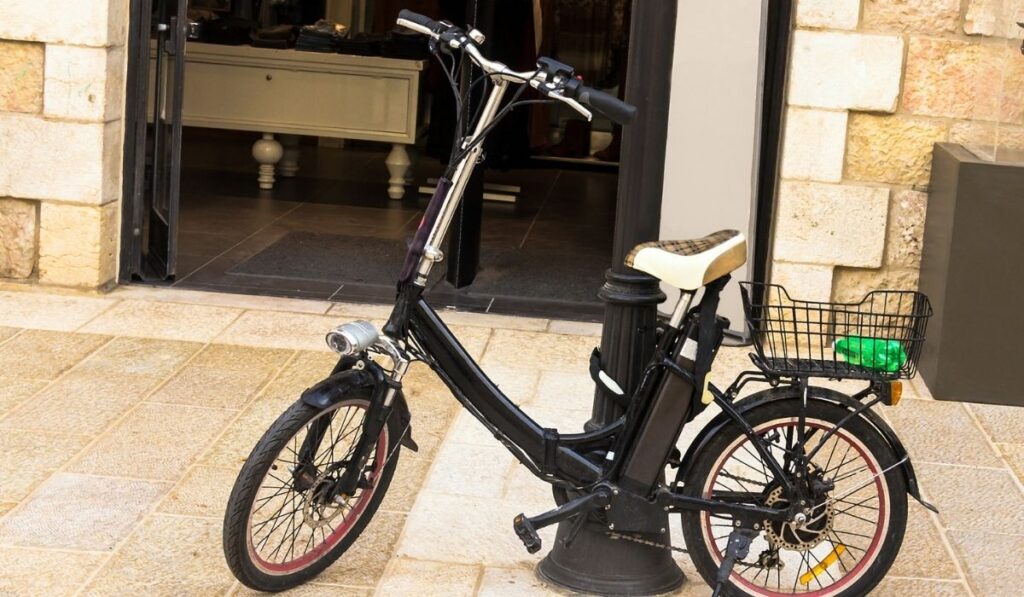Owning an e-bike can be a thrilling experience. There’s nothing like riding your bike when the weather is pleasant, warm, or even maybe through a little drizzle. But what about when you’re not riding your bike? Is it OK for them to sit out in the weather since, after all, they’re designed to be used in that same weather?
Storing your E-Bike outside in the elements can weaken its components, reducing the bike’s lifespan. Extreme heat can also overheat your bike’s electrical components. If you need to store it outside, buy a shed or waterproof covering (tarp) for your bike, and be sure to store the battery inside.
While some may argue that an e-bike is like a regular bike and can be placed outside, this is not the case. But if storing your e-bike indoors is not possible, we will show you how to keep it outdoors properly, while also preventing damage and keeping the resale value high.
Why Shouldn’t You Store Your e-Bike Outside?

While it might seem like it would be okay to store your e-bike outside since it functions similarly to a car motor, that isn’t the case. Moisture would be able to get inside it due to rain and other weather conditions and corrode its different components, as you will discover in this article.
Here are some of the issues you’ll most likely encounter if you opt to store your e-bike outside.
Water Damage
A little bit of rain might not do much damage to your e-bike, but long-term exposure will do a lot of harm. Here are some of the bike components that will suffer from exposure to water or moisture.
- Chains: Because they are made from metal, they will eventually rust if exposed to rain and moisture.
- Cables: If you have stainless steel cables exposed outside the frame, oxidation will occur, which will eventually affecting the quality of your braking and shifting.
- Seals: Due to the slow degradation of seals over time, moisture and water can easily seep their way inside your bike. Some of the components that will be affected are the wheel hubs, shifters, headsets, rear derailleurs, and bottom brackets.
- Bolts: Though the bolt metals may be different from the metal of other bike components, rain and moisture can still cause them to seize up and get stuck. You will find it hard to remove them once they get stuck due to corrosion.
- Rubber and plastic: Apart from metallic components, your e-bike will be made up of other materials. The brake hood, tires, and seats are rubber and plastic. If those parts are exposed to water and moisture, then eventually, they will get damaged.
- Stainless steel frame: Rust starts to develop faster when your frame is made of steel. Corrosion can start occurring from the inside as well, making it very unsafe to ride your bike.
Extreme Heat Due to Sunlight
Water damage is dangerous, but it might not even be the biggest problem if you store your e-bike outside. Extreme heat from can cause the following:
- Your e-bike colors fading due to long-term exposure to the sun.
- Your e-bike’s electrical components can overheat.
- Even without constant exposure to the sun, your bike can erode over time.
- Long-term exposure to the sun will cause plastic and rubber parts and seals to be broken.
- Your e-bike’s housing cable has some sheath on the outer end, breaking down and cracking. Wires from the housing will come out.
How can You Protect Your E-Bike When Stored Outside?

Although it is preferred to store your e-bike indoors, if you cannot do so due to unforeseen circumstances, don’t worry.
Corrosion takes different amounts of time depending on where you live. It will take a month to notice deterioration in locations with a lot of rain and sunshine, but it may take several months in milder climates.
In the meantime, here are some steps you may do to slow down the deterioration process:
- Consider building a shed: If you have an open area where you can have a shed, it would be good to invest in one. There are several places you can buy a shed for your E-bike, Amazon being one of them. Here are links to two: the YardStash 3 Sheds & Outdoor Storage and the Keter Store-It-Out Ultra Outdoor Garden Storage (on Amazon).
- Check your bike’s seals: Consider replacing them if they are more than five years old. Rain and moisture will tend to get into your frame and components to a considerable extent.
- Buy a waterproof bike cover: These cover are rainproof, anti UV, and are made of durable tarp that will cover your whole bike. They can protect your bike from the elements. E-bike covers have both front and back lock holes for security. Check this bike cover on Amazon: TeamObsidian Bike Cover (on Amazon).
- Take care of the rust: If you notice rust has started creeping in, you need to get rid of it quickly. Scraping it off is one way of taking care of it. You can do this without damaging the parts using a thin sheet of tin foil. You can also put on some oil, W-40 being an especially good option to use.
- Grease your frames and components: Greasing the most-likely-to-oxidize parts will prevent water from getting in. The grease will act as a second barrier. Lubing your cables, bolt heads, and any moving parts will prevent them from seizing up.
How do You Store an E-Bike For Winter?
If you have no choice but to store your bike outside, disconnecting the battery is essential. Even if the remainder of the E-bike is being held outdoors, be sure the battery is not left outside.
Why is it recommended that you remove your E-bike battery and store it indoors at all times? Your bike’s battery won’t survive the cold, and it’s also a costly part of the bike. Replacing it would be quite expensive. However, even if the battery is placed indoors, it must be cared for.
Here are a few tips:
- You need to recharge your battery regularly. The battery charge should be between 30%-60% maximum. Do this throughout the winter.
- Once winter is over, make sure you charge your battery 100% before putting the battery back into the bike and riding off.
- The room temperature you want to store your battery should be between 18-22°C (64 – 71°F).
- Take time to inspect if your battery has any oil leaks.
Summary:
You’ve seen how you can protect your E-bike from the elements even if you have no choice but to store it outside. Even while stored outside, the E-bike can be kept in excellent condition.
We’ve shown you how to store your E-bike battery even in the middle of winter. Make sure to check out our other E-bike posts to learn more about proper maintenance and care.
